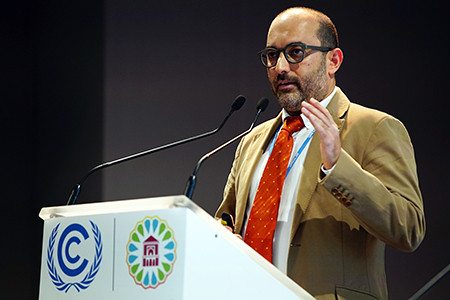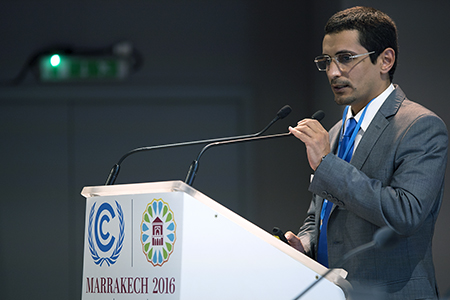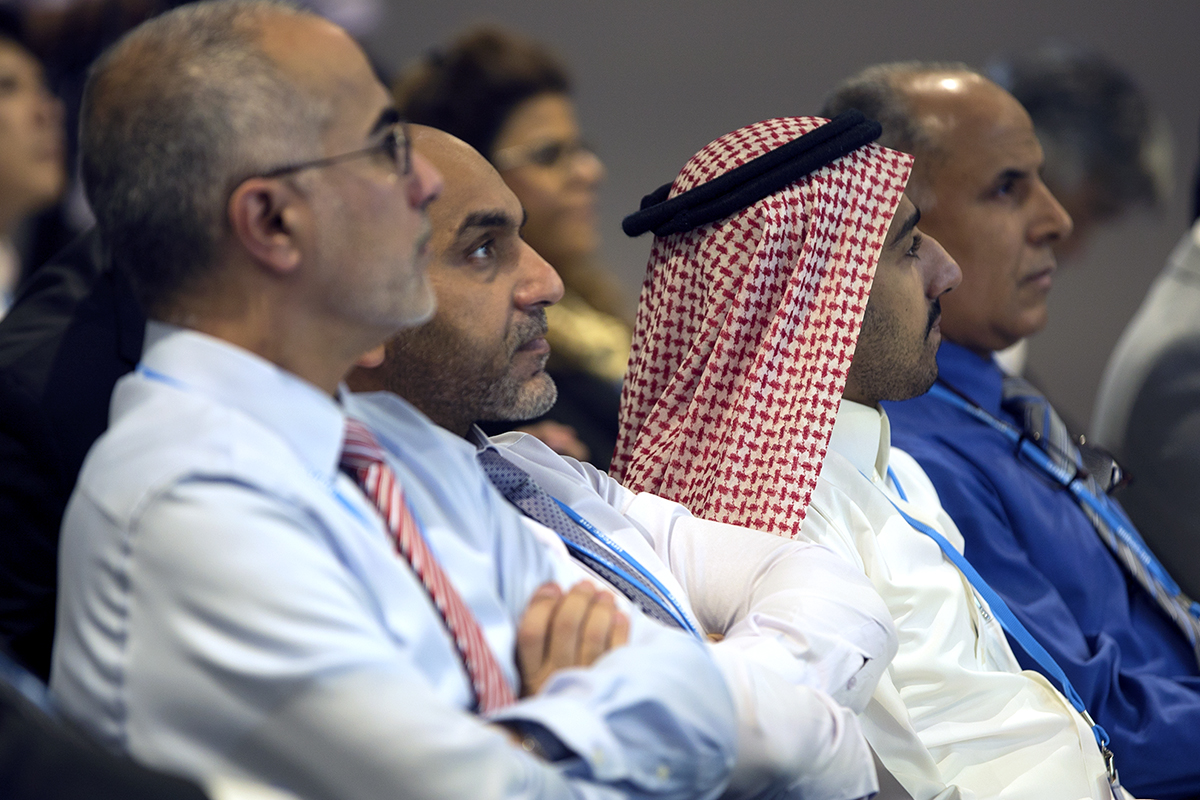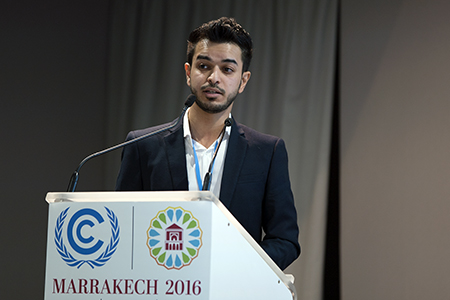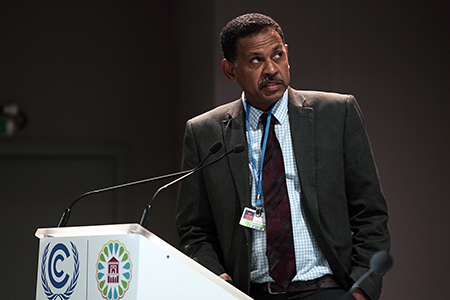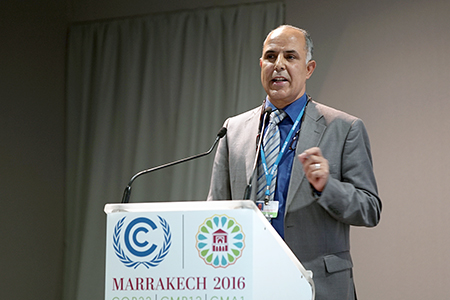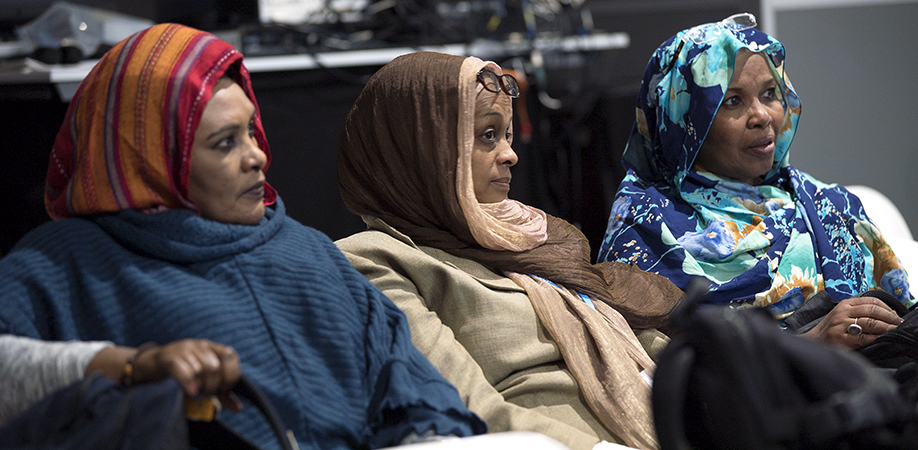Summary
IISD Reporting Services is providing coverage of selected GCC Pavilion events at the 2nd Conference of the Parties (COP 22) to the UN Framework Convention on Climate Change (UNFCCC), including written, digital and video coverage.
- Creating Value from CO2
- Building Resilience and Adaptation Measures with Co-mitigation Benefits in the Red Sea and the Arabian Gulf
Photos by IISD/ENB | Liz Rubin
For photo reprint permissions, please follow instructions at our Attribution Regulations for Meeting Photo Usage Page
Creating Value from CO2Presented by the Gulf Cooperation Council
Nouf Aburas, Ministry of Energy, Industry and Mineral Resources, Saudi Arabia, moderated this event, which focused on: sharing of efforts; progress and perspectives regarding future market potential for carbon capture and sequestration (CCS); and transportation and conversion into alternative industrial uses, including chemicals, cement manufacturing, food and waste treatment.
Tidjani Niass, Saudi Aramco, described: a past initiative, which transformed methane from waste, avoiding 80 million tons of CO2 annually since 1980; and an energy management programme that fosters energy efficiency due to cogeneration capacity and flaring reduction, savings 127 million tonnes of CO2 since 2000. He highlighted challenges that need to be overcome regarding CCS, including: high capital and operating cost; availability of storage capacity; lack of tailored-policy mechanisms; and the need to raise public awareness. Niass explained that instead of storing the captured CO2, it can be used in many applications, such as fuel production, chemicals, enhanced oil recovery, food, power and energy resources, carbonates, and polymers. He said many small start-up companies are being developed to use captured CO2.
Abdulaziz Al-Jodai, Director, Saudi Arabia Basic Industries Corporation (SABIC), talked about his company’s investments in extracting flue gas and reducing greenhouse gas emissions through carbon purification processes and applications in different industries, including chemicals, polymers, agri-nutrients and metals. He noted that SABIC developed the first complete commercial technology to purify CO2 in its world biggest plant. He outlined SABIC’s purification process flow and concluded that new uses for captured CO2 have been made possible via the pipeline system that delivers it to industrial consumers such as urea plants.
Nafisi Al Nafisi, Greencarbon Initiative of the Al Nafisi Industries, Kuwait, outlined the roadmap to CO2 mitigation in his region. He noted his work focuses on assisting private and public sectors to develop business models that overcome CCS challenges to use captured CO2 in sustainable applications, including beverage carbonation, anti-microbial preservation, food freezing and in-transit refrigeration. He noted captured CO2 is being used as a substitute for chemicals that treat wastewater.
Mubarak Malhiya, Qatar Fuel Additives Company Limited (QAFAC), explained his company’s use of methane recovery, which can be used to produce inputs to be used as a fuel additive. He outlined QAFAC’s environmental programmes, including flare management, leak detection and repair, and a green belt development and zero-treated wastewater discharge. He highlighted the new QAFAC project started in 2014 to recover 500 MT per day of CO2 and inject it back into a methanol plant to increase production and minimize CO2 emissions.
In the ensuing discussion, participants addressed: technological CCS challenges for carbon capture, storage and reuse; the cost of recovery and purification, which depends on CO2 concentration, the utilities available and the capacity of the plant; and the importance of lifecycle analysis and carbon footprint to help decide if an application for captured CO2 is climate-friendly.
(L-R): Abdulaziz Al-Jodai, Director of SABIC; Tidjani Niass, Saudi Aramco; Nouf Aburas, Ministery of Energy, Industry and Mineral Resources, Saudi Arabia; Nafisi Alnafisi, Greencarbon Initiative of the Al Nafisi Industries, Kuwait; and Mubarak Malhiya, QAFAC
Tidjani Niass, Saudi Aramco
Nafisi Alnafisi, Green Carbon Initiate of the Alnafisi Industries, Kuwait
Mubarak Malhiya, Qafac showcase CCS
Nouf Aburas, Ministery of Energy, Industry and Mineral Resources, Saudi Arabia
Participants listen to panelists
Abdulaziz Al-Jodai, Director of SABIC
Contacts:
- Abdulhadi Nasser Almarri
| analmarri@mme.gov.qa
More Information:
- http://www.sabic.com/corporate/en/
- http://www.saudiaramco.com/en/home.html
- http://greencarbon-me.com/about/
- https://www.qafac.com.qa/
Building Resilience and Adaptation Measures with Co-mitigation Benefits in the Red Sea and the Arabian GulfPresented by PERSGA
Ali Qasem, Saudi Aramco, moderated the event that showcased the Arabian Gulf, Red Sea and Gulf of Aden regions’ efforts in their adaptation actions through ecosystem solutions.
Khaled Al-Abdulkader, Saudi Aramco, outlined the potential to increase seafood supply via small and medium-size enterprises in Saudi Arabia. He summarized policies to avoid overexploitation and habitat degradation and to ensure fisheries sustainability in the Arabian Gulf, while increasing production. To establish a framework for managing fisheries resources, he highlighted the importance of: assessing commercial fisheries stocks; identifying relevant habitats; determining the impacts of current fishing practices; and deploying artificial reefs.
Faisal Alshuayl, High Commission of the Development of Arriyadh, Saudi Arabia, presented his city’s storm water drainage strategy, which was completed in 2014. To address rapid urban development and increased urban runoff and flooding, he outlined the city’s updated masterplan to mitigate current risks. He cited some environmental solutions, including the use of sustainable urban drainage systems and green roofs.
Hashem Al-Sada, Energy Conservation Department, Qatar General Electricity & Water Corporation (KAHRAMAA), Qatar, described the energy intensity of water pumping, desalination, consumption and re-use. He outlined various measures used to manage and save water, reducing the carbon footprint in both the supply and demand sides. He explained that some policies focused on the highest consumption consumers in each economic sector to achieve water savings of 35% in 2015.
Ahmed Khalil, The Regional Organization for the Conservation of the Red Sea and Gulf of Aden (PERSGA), explained that PERSGA supports alternative livelihoods for vulnerable coastal communities with projects on: sustainable fisheries; ecotourism; diversification of commodities; pollution control; and ecosystem approaches to fisheries management and aquaculture development. He noted the importance of monitoring and coordinating regional conservation actions, and sharing experiences and knowledge among member states.
Maher Amer, PERSGA, highlighted the global conservation value of marine ecosystems for local communities in the Red Sea and Gulf of Aden. He also noted the economic benefits derived from marine protected areas, including: sustaining food resources and livelihoods; promoting poverty reduction; creating jobs; and generating tourism revenue. He noted the importance of effective management to: create resilience; replicate representative habitats; protect critical areas to serve as replenishment of ecological functions; and maintain biodiversity and ecological connectivity among and between habitats.
Hussien Al-Kisswani, Jordan, summarized the vulnerability of coastal ecosystems in the Gulf of Aqaba. He described adaptation measures recommended to combat climate change: coral re-planting in less impacted sites; monitoring systems for ecosystems and species; increased understanding fishing activities; guidelines for implementation of integrated coastal zone management; and training and building capacity regarding such measures.
In the ensuing discussion, participants addressed: re-use of water for irrigation systems; GHG emission scenarios used by Jordan to develop its adaptation strategy; local community participation in fisheries management of protected areas; use of sustainable urban drainage systems; and ways to reduce the carbon water footprint per capita in Qatar.
(L-R): Hashem Al-Sada, Energy Conservation Department, Qatar General Electricity & Water Corporation (KAHRAMAA), Qatar; Hussien Al-Kisswani, Jordan; Faisal Alshuayl, High Commission of the Development of Arriyaadh, Saudi Arabia; Khaled Abdulkader, Saudi Aramco; Ali Qasem, Saudi Aramco; Ahmed Khalil, PERSGA; and Maher Amer, PERSGA
Hashem Al-Sada,
Kahramaa Energy Conservation Department
Faisal Alshuayl, High Commission of the Development of Arriyaadh, Saudi Arabia, presented the city of Arriyaadh storm water drainage strategy.
Ahmed Khalil, PERSGA, noted the coordinating and networking of regional conservation actions and sharing of experiences and knowledge among member states.
Maher Amer, PERSGA, highlighted the limited but valuable living resources in the Red Sea and Gulf of Aden.
Participants during the event
Contacts:
- Hamoud AlOtaibi
| otaibihr@yahoo.com



